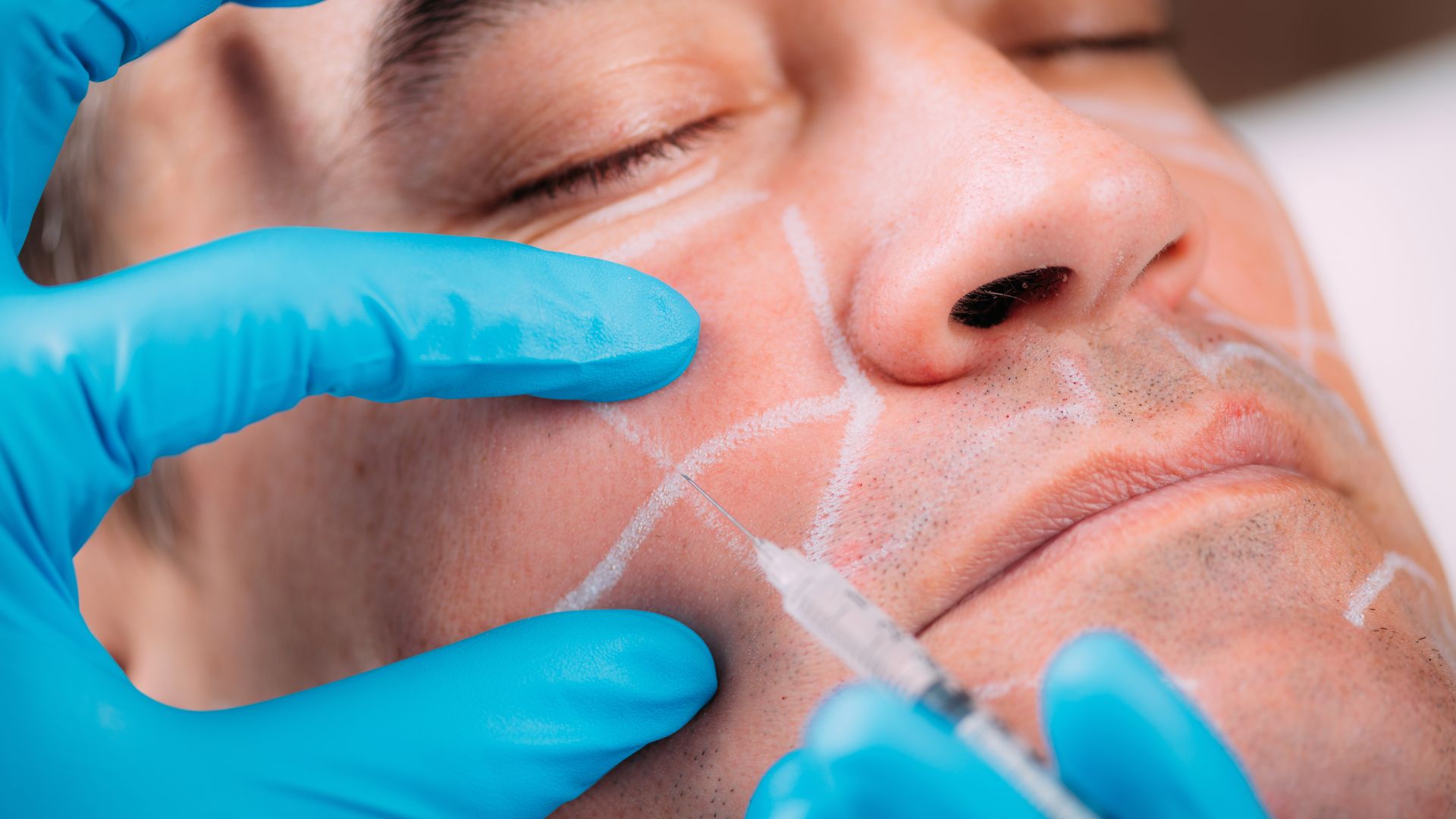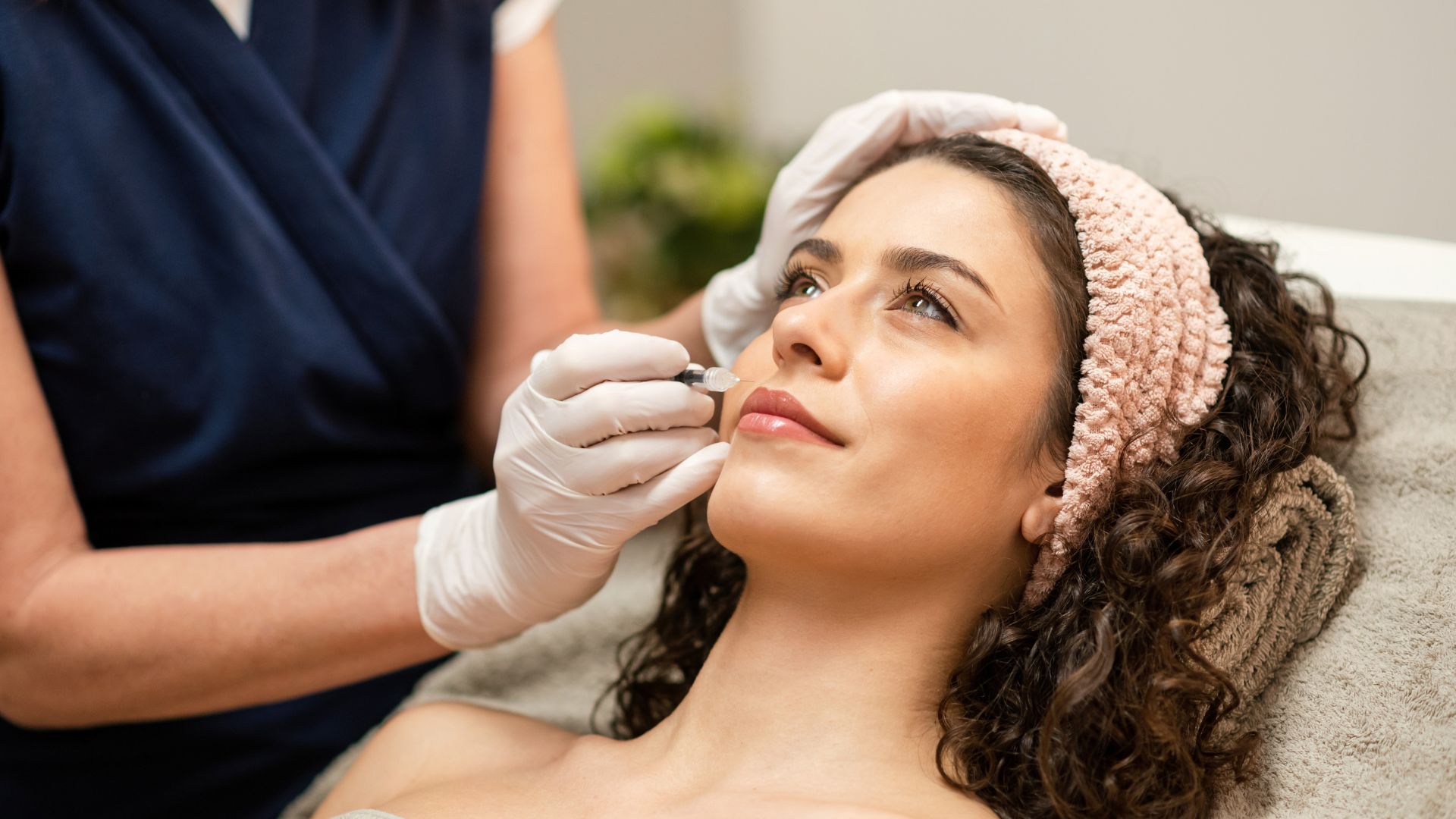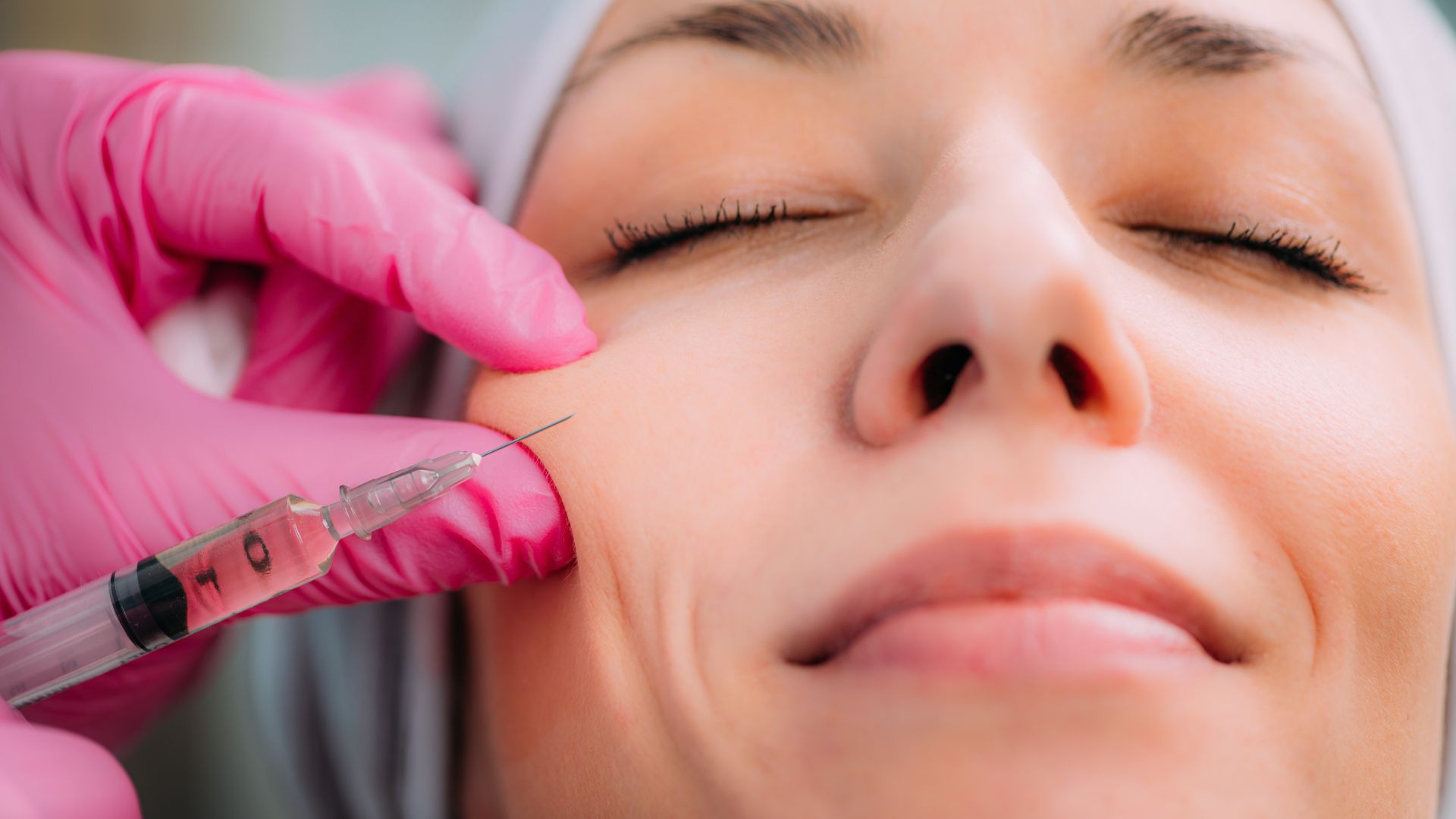Cheek fillers have become an increasingly popular cosmetic procedure in aesthetic medicine, offering patients a non-surgical option to enhance their facial structure and achieve a more youthful appearance.
According to Forbes, dermal filler procedures, including cheek augmentation, have seen a significant rise, with over 5.3 million procedures performed in 2023 alone. The growing demand underscores the importance of mastering the techniques and understanding the anatomy involved in cheek filler injections.
This article aims to provide a comprehensive guide to cheek filler injection sites, focusing on helping licensed medical professionals enter the world of aesthetics with confidence and precision.
This guide covers:
- Understanding Cheek Anatomy
- Types of Cheek Fillers
- Key Injection Sites for Cheek Fillers
- Aesthetics Medical Training: Get Your Dermal Filler Certification
Whether you’re new to aesthetic medicine or looking to refine your skills, this cheat sheet is designed to enhance your knowledge and practice. Let’s dive in!

Understanding Cheek Anatomy for Effective Cheek Filler Placement
Understanding cheek anatomy is fundamental for any practitioner aiming to perform safe and effective cheek filler placement. Knowing the precise cheek filler injection sites and functions of various anatomical structures helps in achieving optimal results and minimizing complications.
Key Anatomical Structures of the Cheek
The cheek region is a complex area with several critical components:
- Bone Structure: The zygomatic bone, or cheekbone, provides the foundational support and projection for the cheeks. Enhancing the malar projection with fillers can create a youthful and defined appearance.
- Fat Pads: The cheeks contain various fat pads, including the submalar fat pad and the lateral sub-orbicularis oculi fat (SOOF). These fat pads contribute to facial volume and contours. Age-related volume loss in these areas can lead to a sunken appearance, which fillers can address.
- Muscles: Muscles such as the orbicularis oculi and the zygomaticus major and minor play crucial roles in facial expressions. Understanding their locations helps avoid disrupting natural facial movements during filler injections.
- Blood Vessels: The infraorbital artery, angular artery, and labial artery are significant blood vessels in the cheek region. Knowledge of these vascular structures is vital to prevent vascular occlusion, a serious complication that can occur if a filler is injected into a blood vessel.
- Facial Tissue and Skin: The overlying skin and connective tissue vary in thickness and elasticity. Recognizing these differences is important for choosing the right filler type and injection technique to achieve natural-looking results.
Visual Aids for Precise Cheek Filler Injection Points
Incorporating visual aids such as diagrams and illustrations can significantly enhance the understanding of cheek anatomy and allow access to precise cheek filler injection points. These visuals can highlight:
- The locations of key anatomical structures.
- Safe zones for cheek filler injections.
- Areas to avoid to prevent complications.
For instance, a diagram showing the infraorbital artery‘s path can help practitioners avoid this critical blood vessel during injections.
Additional Reading: Looking to become a cosmetic nurse? You’ll want to read How to Become an Aesthetic Nurse – The Art of Beauty Medicine.
In conclusion, a detailed knowledge of cheek anatomy is indispensable for performing safe and effective cheek filler procedures. By understanding the underlying structures, healthcare providers can achieve optimal aesthetic results, minimize risks, and ensure patient satisfaction.
Types of Cheek Fillers
When it comes to cheek fillers, there are several types available in the market, each offering unique benefits and considerations. Understanding these options helps practitioners select the best injectable filler based on patient needs and desired outcomes.
- Hyaluronic Acid Fillers: Hyaluronic acid (HA) fillers, such as Juvederm and Restylane, are among the most popular choices for cheek augmentation. Hyaluronic acid is a naturally occurring substance in the body that helps maintain skin hydration and volume. According to the American Society for Aesthetic Plastic Surgery (ASAPS), hyaluronic acid fillers were the second most popular non-surgical cosmetic procedure in 2023, highlighting their widespread use and patient satisfaction.
- Calcium Hydroxylapatite Fillers: Calcium hydroxylapatite (CaHA) fillers, such as Radiesse, are another popular option for cheek augmentation. These fillers consist of calcium-based microspheres suspended in a gel carrier. A study published in the Journal of Clinical Medicine found that patients treated with CaHA fillers showed significant improvement in facial volume and contour, with a high rate of satisfaction.
- Poly-L-Lactic Acid Fillers: Poly-L-lactic acid (PLLA) fillers, such as Sculptra, work differently from HA and CaHA fillers. They stimulate collagen production, leading to gradual volume restoration over several months. According to a systematic review in Aesthetic Plastic Surgery, PLLA fillers have a favorable safety profile and are effective in treating age-related volume loss.
- Fat Grafts: Fat grafting, also known as fat transfer, involves harvesting fat from one part of the patient’s body and injecting it into the cheeks. Seminars in Plastic Surgery reports that fat grafting provides high patient satisfaction and long-lasting results when performed by experienced practitioners.

Choosing the Right Filler
Selecting the appropriate filler depends on various factors, including the patient’s aesthetic goals, facial anatomy, and desired longevity of results. Here are some considerations:
- Patient Goals: Understanding whether the patient desires subtle enhancement or significant volume can guide the choice between HA, CaHA, or PLLA fillers.
- Facial Anatomy: The patient’s existing facial structure and volume loss should be assessed to determine the most suitable filler type and injection approach.
- Longevity of Results: Patients seeking longer-lasting results may prefer CaHA or PLLA fillers, while those desiring reversible treatments might opt for HA fillers.
Additional Reading: You might also want to take a look at How to Become a Lip Injector: Training, Techniques, and Tips.
Understanding the different types of cheek fillers available allows practitioners to tailor treatments to each patient’s unique needs and goals. By considering the pros and cons of each filler type and the patient’s specific anatomy and desired outcomes, practitioners can achieve natural-looking and satisfying results.
Key Cheek Filler Injection Sites
Achieving optimal results with cheek fillers hinges on understanding and precisely targeting key injection sites. Each site offers unique benefits for enhancing facial contours, addressing volume loss, and creating a youthful appearance. Below is a detailed breakdown of the primary cheek filler injection sites along with tips for precise injection techniques, common mistakes to avoid, and troubleshooting tips.
1. Submalar Area: Enhancing Cheekbone Definition
The submalar area, located just below the cheekbone, is crucial for enhancing cheekbone definition and adding volume to sunken cheeks. This cheek filler injection point is ideal for creating a more contoured and lifted appearance.
Injection Techniques:
- Linear Threading Technique: Inject the filler in a linear fashion parallel to the cheekbone to create a smooth, even distribution.
- Multilayering Approach: Use a combination of superficial and deep injections to achieve a more natural look and prevent overfilling.
Tips for Precision:
- Ensure the needle is positioned correctly to avoid the infraorbital artery, which runs close to this area.
- Gradually build up the volume, allowing for adjustments and avoiding the risk of overcorrection.
Common Mistakes to Avoid:
- Overfilling, which can lead to an unnatural and puffy appearance.
- Incorrect needle depth, which may result in visible filler lumps or nodules.
2. Zygomatic Arch: Creating a Lifted and Contoured Look
The zygomatic arch, or the cheekbone itself, is a prime site for creating a lifted, contoured look. Enhancing this area can significantly improve the overall facial structure and profile.
Injection Techniques:
- Deep Injection: Place the filler deeply along the zygomatic arch to provide structural support and lift.
- Linear Threading Technique: Similar to the submalar area, this technique helps in achieving a smooth and natural contour.
Tips for Precision:
- Focus on the angles of projection to ensure the filler enhances the natural bone structure.
- Use a fine-gauge needle to minimize discomfort and ensure precise placement.
Common Mistakes to Avoid:
- Injecting too superficially, which can result in visible filler and an uneven surface.
- Neglecting to assess the patient’s overall facial balance, leading to disproportionate enhancement.
3. Midface and Tear Trough: Addressing Volume Loss and Hollowing
The midface and tear trough areas are critical for addressing age-related volume loss and hollowing under the eyes. Fillers in these regions can rejuvenate the appearance by smoothing out hollow areas and reducing the appearance of dark circles.
Injection Techniques:
- Microcannula Technique: Using a microcannula helps in placing the filler precisely and reduces the risk of bruising and swelling.
- Serial Puncture Technique: This involves multiple small injections to ensure even distribution and natural results.
Tips for Precision:
- Avoid the infraorbital artery and other major blood vessels to reduce the risk of vascular occlusion.
- Use a conservative amount of filler initially and reassess after a few weeks to determine if additional volume is needed.
Common Mistakes to Avoid:
- Overfilling, which can lead to the Tyndall effect, where the filler creates a bluish tint under the skin.
- Placing the filler too superficially, resulting in visible lumps and irregularities.

General Tips for Precise Injection Techniques
- Patient Assessment:
- Thoroughly assess the patient’s facial anatomy and volume loss to create a personalized treatment plan.
- Discuss the patient’s aesthetic goals to ensure realistic expectations and satisfaction.
- Technique Refinement:
- Stay updated with the latest injection techniques through continuous education and training.
- Practice a steady hand and precise movements to minimize risks and achieve natural-looking results.
- Avoiding Common Mistakes:
- Use a topical anesthetic to reduce patient discomfort and improve the overall experience.
- Monitor for any signs of complications, such as vascular occlusion, and be prepared to manage them promptly.
Additional Reading: Have you decided to specialize in dermal filler procedures? Check out How to Become a Dermal Filler Injector.
Understanding and mastering the key cheek filler injection sites are essential for achieving optimal aesthetic results. By employing precise techniques and avoiding common mistakes, practitioners can enhance their patients’ natural beauty and restore youthful volume.
Patient Assessment and Consultation
A comprehensive patient assessment is the foundation of successful cheek filler treatments. It involves evaluating the patient’s facial anatomy, skin type, and overall health to determine the best approach and type of filler to use. This step is critical for several reasons:
- Customized Treatment Plans: Each patient has unique facial contours, bone structure, and skin characteristics. By assessing these factors, practitioners can tailor the treatment plan to enhance the patient’s natural beauty and achieve the desired youthful appearance.
- Risk Mitigation: Identifying potential risks, such as allergies, previous cosmetic procedures, and medical conditions, helps in preventing complications.
- Optimal Results: Understanding the patient’s specific needs and goals allows for precise filler placement, leading to natural-looking results and high patient satisfaction.
Key Factors to Consider
When assessing a patient for cheek filler treatments, several key factors should be considered:
- Facial Symmetry: Analyzing facial symmetry is essential for achieving balanced and harmonious results. Assess the differences between the two sides of the face and plan the filler placement accordingly.
- Skin Type and Texture: Different skin types respond differently to fillers. For instance, thicker skin may require deeper injections, while thinner skin may need more superficial placement to avoid visibility of the filler. Consider the skin’s elasticity, hydration, and presence of fine lines or wrinkles.
- Patient Goals: Understanding the patient’s aesthetic goals is vital. Some patients may seek subtle enhancements, while others may desire more dramatic changes. Discuss their expectations and explain the achievable outcomes based on their facial structure and the type of filler used.
A thorough patient assessment and effective communication are essential components of successful cheek filler treatments. By considering facial symmetry, skin type, and patient goals, and by using clear communication strategies, practitioners can create personalized treatment plans that enhance natural beauty and achieve high patient satisfaction.

Get Your Dermal Filler Certification with Aesthetics Medical Training – Enroll Today!
At Aesthetics Medical Training (AMT), we are dedicated to advancing the field of aesthetic medicine by providing top-tier education and training for licensed medical professionals. Our mission is to equip practitioners with the knowledge and skills needed to deliver safe, effective, and cutting-edge cosmetic treatments that enhance natural beauty and meet the unique needs of every patient.
Comprehensive Virtual Classes and Hands-On Training Programs
Our curriculum is designed to offer a blend of comprehensive virtual classes and hands-on training programs, ensuring that you receive a well-rounded education. Whether you’re new to the field or looking to refine your skills, AMT provides the resources you need to succeed.
Enhance Your Skills and Succeed in Your Aesthetics Career
Ready to take your expertise to the next level? Visit our online training center to explore our courses and enroll today. Join the ranks of skilled aesthetic practitioners who are transforming the field of aesthetic medicine with their advanced knowledge and superior technique.
Enroll Today!
At AMT, we are committed to helping you achieve the patient’s aesthetic goals and deliver outstanding results for them. Whether you’re aiming to enhance facial contours, address age-related volume loss, or perfect your cheek filler techniques, our training programs are designed to support your professional growth and success.
Discover the future of aesthetic medicine training with AMT – where excellence in education meets unparalleled practical experience. Contact us today!

